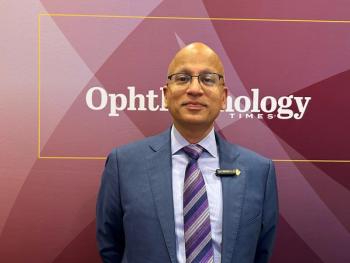
‘Locking in’ lens power
A light-adjustable IOL continues to show potential for delivering customized vision with predictable results.
Take-Home
A light-adjustable IOL continues to show potential for delivering customized vision with predictable results.
Robert Maloney, MD, director of the Maloney Vision Institute, Los Angeles, discusses the clinical results and current status of the Light Adjustable Lens (Calhoun Vision) in phase II FDA study.
Tijuana, Mexico-Delivery of customized vision with predictable results may be as close as next-generation technology associated with a light-adjustable IOL (Light Adjustable Lens, Calhoun Vision).
The primary difference between the light-adjustable IOL and other IOLs is the predictable correction of residual refractive error after lens implantation for optimal distance vision. Another difference is the opportunity for customized presbyopia solutions for near and intermediate vision, according to Arturo S. Chayet, MD, medical director, Codet Vision Institute, Tijuana, Mexico.
How it works
The procedure involves a conventional cataract surgery that is followed by adjustment of the light-adjustable IOL 2 weeks later. A light-delivery device is used to irradiate the IOL with a spatially profiled beam. Dr. Chayet explained that over the subsequent 24 hours, the shape of the IOL changes to correct residual spherical and/or astigmatic errors. From between 2 days to 1 week after the irradiation procedure, and with both the surgeon and patient satisfied with the refractive power, the lens power is “locked in.”
The lens, made of silicone, undergoes a photopolymerization process after exposure to the adjustment beam. The subsequent diffusion and power change depend on the profile used, which adds power to the lens. The lock-in procedure ensures that the achieved lens power remains stable.
The results from various studies of correction of refractive errors with the lens have been very good, Dr. Chayet noted. With hyperopia and myopia, about 93% of eyes were within ±0.25 D of the intended correction; for astigmatism, all eyes were within about 0.5 D of the intended adjustment. The postoperative uncorrected visual acuity was 20/20 in 86% of patients 12 months after the lock-in procedure.
Toric correction
The light-adjustable IOL also has several benefits for toric correction, according to Dr. Chayet. The same technique is always used for wound placement and IOL placement, the accuracy is within 0.25 D of cylinder and within 1° of the axis, the overall refractive accuracy of sphere and cylinder is very high, up to 2.5 D of cylinder can be corrected, and it can be used along with multifocal corrections, he noted.
A study that compared results for the light-adjustable IOL with those for a toric IOL (AcrySof toric, Alcon Laboratories) showed that 86% of patients with the light-adjustable IOL implanted had 20/20 or better uncorrected visual acuity postoperatively compared with about 30% with the toric IOL.
Presbyopia correction
Among the approaches for presbyopia with the lens:
- Adjustable monovision goes beyond the typical monovision. The implant is inserted in the dominant eye and adjusted for emmetropia, while the non-dominant eye is targeted initially for –1.25 D after the implantation and before the adjustment. During the postoperative evaluation, the adjustment can be locked in or adjusted based on patient preference. Patients who chose this option achieved 20/20 near vision (J1).
- With customized near vision, the dominant eye can be adjusted to emmetropia; the non-dominant eye can undergo a postoperative adjustment that targets +0.25 D and after the second adjustment, a near add adjustment can be made. Patients with this option also achieved 20/20 near vision (J1). The results from phase II of this approach, in which no adjustment has to be made for photopic vision, showed that 68% of patients achieved 20/20 or better and 73% of patients achieved J2 or better.
- With controlled addition of asphericity, Dr. Chayet cited two benefits: enhanced distance vision and extended depth of focus for improved intermediate and near vision. Using this approach, the aspheric eye retains most distance vision and the fellow eye has excellent distance vision.
Safety
No cases of toxic anterior segment syndrome have developed, indicating that the IOL is highly biocompatible, according to Dr. Chayet. No macular damage has been seen in any in vitro or in vivo studies.
Protective lenses are essential during the first postoperative month.
“The [light-adjustable IOL] is the next-generation IOL technology for both cataract and refractive lens surgery,” he said. “It is truly a refractive procedure for the phaco surgeon and has been proven effective to correct myopia, hyperopia, astigmatism, and presbyopia.
“In the future, we are looking forward to wavefront control using this technology,” Dr. Chayet concluded.
Arturo S. Chayet, MD
Dr. Chayet is a consultant for Calhoun Vision and Nidek. The Light Adjustable Lens is an investigational device and available outside of the United States. This article was adapted from Dr. Chayet’s presentation at Refractive Surgery 2012 during the annual meeting of the American Academy of Ophthalmology.
Newsletter
Don’t miss out—get Ophthalmology Times updates on the latest clinical advancements and expert interviews, straight to your inbox.



















































.png)


